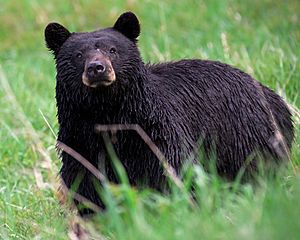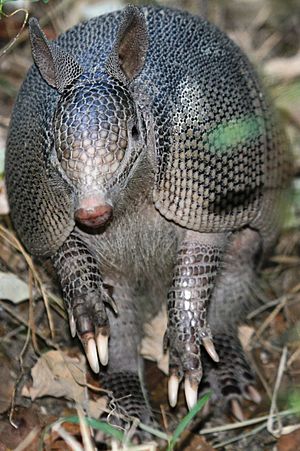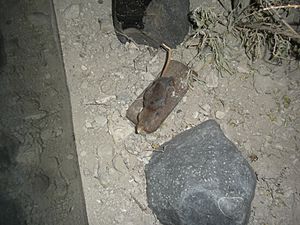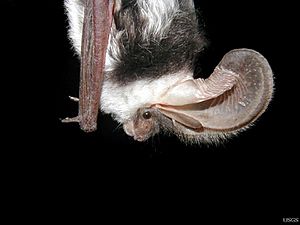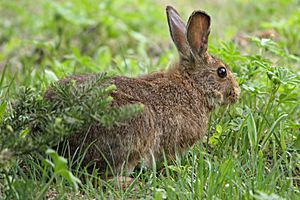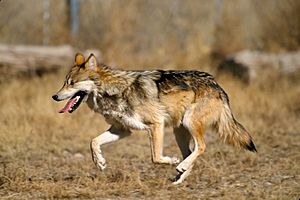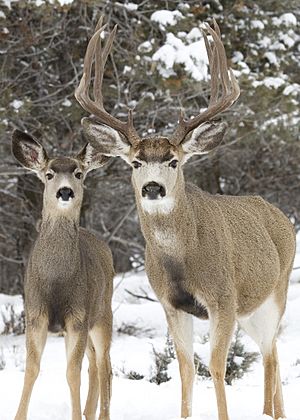List of mammals of New Mexico facts for kids
New Mexico is a state in the southwestern United States. It's home to an amazing variety of animals, especially mammals! From tiny shrews to large deer, New Mexico has many different kinds of furry creatures. This list will introduce you to some of the cool mammals that live in or have lived in New Mexico. Some of these animals were once found here but are now gone (this is called extirpated). Others were brought here by people (these are introduced species).
Contents
Opossums: Amazing Marsupials
Family: Didelphidae
Opossums are unique mammals because they are marsupials. This means the mothers carry their babies in a pouch, just like kangaroos!
- Virginia opossum, Didelphis virginiana
Armadillos: Little Armored Tanks
Family: Dasypodidae
Armadillos are known for their tough, bony armor that protects them. They are skilled diggers and often look for insects to eat.
- Nine-banded armadillo, Dasypus novemcinctus
Shrews: Tiny Hunters
Family: Soricidae
Shrews are some of the smallest mammals around. They have long snouts and tiny eyes. Even though they look a bit like mice, they are actually more closely related to moles. Shrews are very active and need to eat almost constantly to stay alive.
- North American least shrew, Cryptotis parva
- Crawford's gray shrew, Notiosorex crawfordi
- Merriam's shrew, Sorex merriami
- Montane shrew, Sorex monticolus
- New Mexico shrew, Sorex neomexicanus
- American water shrew, Sorex palustris
Bats: Flying Mammals of the Night
Family: Molossidae (Free-tailed Bats)
Bats are the only mammals that can truly fly! They use a special skill called echolocation to find their way and hunt insects in the dark. Free-tailed bats are known for their long, thick tails that stick out beyond their flight membrane.
- Western mastiff bat, Eumops perotis
- Mexican free-tailed bat, Tadarida brasiliensis
Family: Phyllostomidae (Leaf-nosed Bats)
Leaf-nosed bats often have unique nose shapes that help them with echolocation. Some species in New Mexico are important for pollinating plants.
- Mexican long-tongued bat, Choeronycteris mexicana
- Greater long-nosed bat, Leptonycteris nivalis
Family: Vespertilionidae (Common Bats)
This is the largest family of bats. Many of these bats live in caves or trees and eat insects.
- Hoary bat, Aeorestes cinereus
- Pallid bat, Antrozous pallidus
- Townsend's big-eared bat, Corynorhinus townsendii
- Big brown bat, Eptesicus fuscus
- Spotted bat, Euderma maculatum
- Silver-haired bat, Lasionycteris noctivagans
- Western red bat, Lasiurus blossevillii
- California myotis, Myotis californicus
- Little brown bat, Myotis lucifugus
- Fringed myotis, Myotis thysanodes
- Western pipistrelle, Pipistrellus hersperus
Lagomorphs: Hares, Rabbits, and Pikas
Family: Leporidae (Hares and Rabbits)
Lagomorphs are often confused with rodents, but they are a separate group. They have two sets of incisor teeth in their upper jaw, which is different from rodents. Hares are generally larger than rabbits and have longer ears and legs.
- Snowshoe hare, Lepus americanus
- Black-tailed jackrabbit, Lepus californicus
- White-tailed jackrabbit, Lepus townsendii
- Desert cottontail, Sylvilagus audubonii
- Eastern cottontail, Sylvilagus floridanus
- Mountain cottontail, Sylvilagus nuttallii
Family: Ochotonidae (Pikas)
Pikas are small, furry mammals that live in rocky mountain areas. They are known for collecting plants and drying them into "haypiles" for winter food.
- American pika, Ochotona princeps
Rodents: Gnawing Mammals
Family: Castoridae (Beavers)
Rodents are the largest group of mammals. They are known for their continuously growing front teeth, which they use for gnawing. Beavers are famous for building dams and lodges.
- American beaver, Castor canadensis
Family: Geomyidae (Pocket Gophers)
Pocket gophers are burrowing rodents with large cheek pouches they use to carry food. They spend most of their lives underground.
- Yellow-faced pocket gopher, Cratogeomys castanops
- Botta's pocket gopher, Thomomys bottae
- Northern pocket gopher, Thomomys talpoides
Family: Heteromyidae (Kangaroo Rats and Pocket Mice)
These rodents are well-adapted to dry environments. Kangaroo rats can jump long distances and rarely need to drink water, getting moisture from their food.
- Bailey's pocket mouse, Chaetodipus balieyi
- Rock pocket mouse, Chaetodipus intermedius
- Merriam's kangaroo rat, Dipodomys merriamii
- Ord's kangaroo rat, Dipodomys ordii
- Banner-tailed kangaroo rat, Dipodomys spectabilis
Family: Cricetidae (New World Mice, Rats, and Voles)
This is a very diverse family, including many types of mice, voles, and woodrats. They play important roles in their ecosystems.
- Long-tailed vole, Microtus longicadus
- Common muskrat, Ondatra zibethicus
- Northern grasshopper mouse, Onychomys leucogaster
- Brush deermouse, Peromyscus boylii
- White-footed mouse, Peromyscus leucopus
- Pinyon mouse, Peromyscus truei
- Western harvest mouse, Reithrodontomys megalotis
- Hispid cotton rat, Sigmodon hispidus
Family: Muridae (Old World Mice and Rats)
These are common species that were introduced to New Mexico by humans.
- House mouse, Mus musculus (introduced)
- Norway rat, Rattus norvegicus (introduced)
- Black rat, Rattus rattus (introduced)
Family: Dipodidae (Jumping Mice)
Jumping mice have long tails and large hind feet, which help them make impressive leaps.
- Meadow jumping mouse, Zapus hudsonicus
- Western jumping mouse, Zapus princeps
Family: Erethizontidae (New World Porcupines)
Porcupines are famous for their sharp quills, which they use for defense against predators.
- North American porcupine, Erethizon dorsatum
Family: Echimyidae (Spiny Rats and Relatives)
The coypu is an introduced species in New Mexico, originally from South America.
- Coypu, Myocastor coypus (introduced)
Family: Sciuridae (Squirrels, Chipmunks, Marmots, and Prairie Dogs)
This family includes many familiar and active rodents. They are often seen in trees or digging burrows.
- Harris's antelope squirrel, Ammospermophilus harrisii
- Golden-mantled ground squirrel, Callospermophilus lateralis
- Gunnison's prairie dog, Cynomys gunnisoni
- Black-tailed prairie dog, Cynomys ludovicianus
- Yellow-bellied marmot, Marmota flaviventris
- Cliff chipmunk, Neotamias dorsalis
- Least chipmunk, Neotamias minimus
- Rock squirrel, Otospermophilus variegatus
- Abert's squirrel, Sciurus aberti
- Fox squirrel, Sciurus niger
- Southwestern red squirrel, Tamiasciurus fremonti
Carnivorans: Meat Eaters
Family: Canidae (Dogs, Wolves, and Foxes)
This family includes many well-known predators. They are often social animals and hunt in packs or pairs.
- Coyote, Canis latrans
- Gray wolf, Canis lupus (reintroduced)
- Mexican wolf, C. l. baileyi (reintroduced)
- Gray fox, Urocyon cinereoargenteus
- Kit fox, Vulpes macrotis
- Swift fox, Vulpes velox
- Red fox, Vulpes vulpes
Family: Ursidae (Bears)
Bears are large, powerful mammals. While they are carnivores, many bears also eat plants, fruits, and insects.
- American black bear, Ursus americanus
- Brown bear, Ursus arctos (extirpated)
- Grizzly bear, U. a. horribilis (extirpated)
Family: Procyonidae (Raccoons and Relatives)
These animals are known for being clever and adaptable. Many have distinctive facial markings.
- Ring-tailed cat, Bassariscus astutus
- White-nosed coati, Nasua narica
- Raccoon, Procyon lotor
Family: Mephitidae (Skunks)
Skunks are famous for their strong-smelling spray, which they use to defend themselves.
- American hog-nosed skunk, Conepatus leuconotus
- Striped skunk, Mephitis mephitis
- Western spotted skunk, Spilogale gracilis
Family: Felidae (Cats)
This family includes all types of cats, from small bobcats to large jaguars. They are skilled hunters with sharp claws and teeth.
- Canada lynx, Lynx canadensis
- Bobcat, Lynx rufus
- Jaguar, Panthera onca (vagrant - meaning it rarely visits)
- Cougar, Puma concolor
Family: Mustelidae (Weasels, Badgers, Otters, and Martens)
Mustelids are often long-bodied and agile predators. Many are known for their valuable fur.
- Wolverine, Gulo gulo (extirpated)
- North American river otter, Lontra canadensis (reintroduced)
- Black-footed ferret, Mustela nigripes (reintroduced)
- Long-tailed weasel, Neogale frenata
- American mink, Neogale vison
- American badger, Taxidea taxus
Even-toed Ungulates: Hoofed Mammals
Family: Antilocapridae (Pronghorn)
Ungulates are mammals with hooves. The pronghorn is unique because it's the fastest land animal in North America.
- Pronghorn, Antilocapra americana
Family: Bovidae (Cattle, Goats, Sheep, and Antelopes)
This family includes many grazing animals. Some species, like the Barbary sheep and gemsbok, were introduced to New Mexico.
- Barbary sheep, Ammotragus lervia (introduced)
- American bison, Bison bison (reintroduced)
- Bighorn sheep, Ovis canadensis
Family: Cervidae (Deer, Elk, and Moose)
Cervids are known for the antlers that males usually grow and shed each year.
- Moose, Alces alces (vagrant)
- Elk, Cervus canadensis (reintroduced)
- Mule deer, Odocoileus hemionus
- White-tailed deer, Odocoileus virginianius
Family: Suidae (Pigs)
Wild boars are an introduced species in New Mexico.
- Wild boar, Sus scrofa (introduced)
Family: Tayassuidae (Peccaries)
Peccaries are pig-like animals found in the Americas.
- Collared peccary, Dicotyles tajacu


